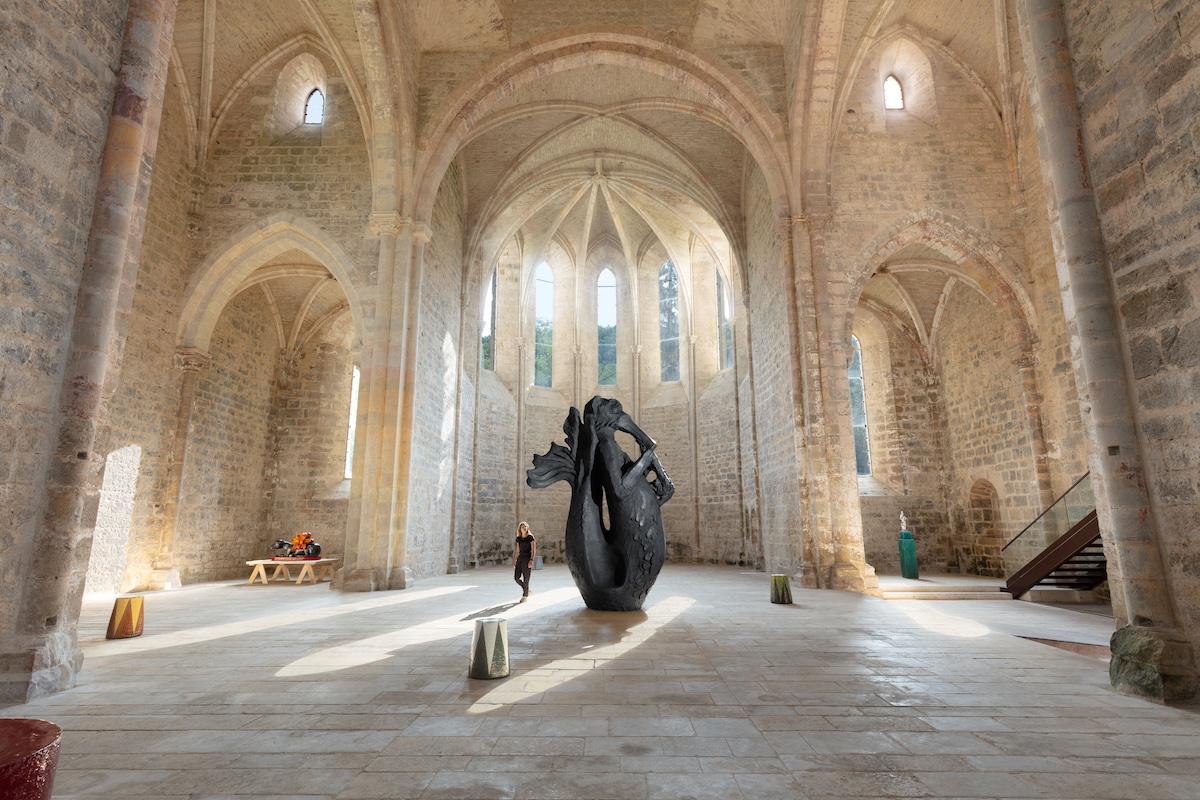
Installation view of Le Cœur qui déborde, carte blanche à Johan Creten at the Abbaye de
Beaulieu-en-Rouergue, Ginals, France.
Hoping to establish an annual tradition, Art & Object invited its regular contributors to share their favorite 2023 exhibitions with our readers. The list below highlights twelve important art events from the past year, some of which we covered at the time and others we did not. Whatever your taste in art, these shows prove that 2023 had something for everyone.
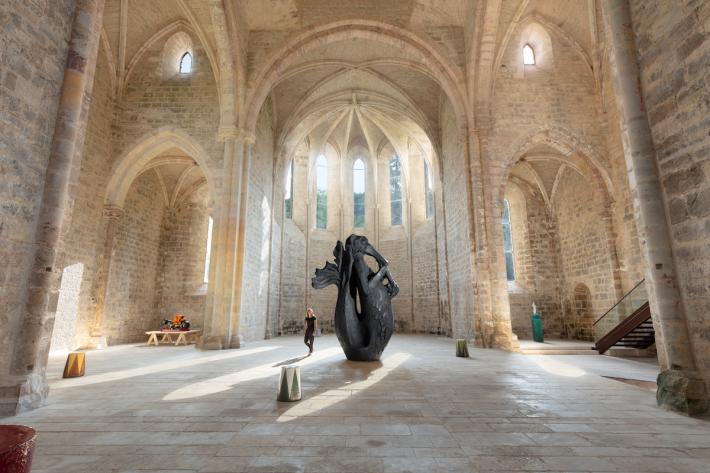
A pioneer in the revival of modern ceramics, Johan Creten is celebrated for his allegorical sculptures in ceramic and bronze. Born in Belgium and based in France, the Flemish artist was trained as a painter but transitioned to working with clay in the late-1980s. Dubbed “The Clay Gypsy,” he has created his imaginative sculptures in craft studios and artist residencies around the world—only recently adding a kiln to his substantial studio in Montrueil, a bohemian suburb of Paris.
The first big contemporary art exhibition since the Beaulieu-en-Rouergue Abbey was reopened after renovations, Le Cœur qui déborde (An overflowing heart) presented nearly 40 ceramic, bronze and resin sculptures in the nave of the abbey church, its cellar and the chapter house, where each carefully placed piece engaged the former Cistercian monastery’s Gothic architecture. Large glazed stoneware figures of sirens and seahorses formed a procession in the church that led to a giant resin seahorse, Le Grand Hypocrite, which was flanked by sculptures of a big ceramic dog and a bronze female fertility figure. Creten’s surreal bronze beast, Le Cœur qui déborde, commanded the upstairs chapter house, while the lower levels sported a tranquil ceramic garden and a darkened cellar with gold abstract wall sculptures spiritually lit by natural light. And with circus-style stools scattered around as points of observation, Creten’s staged scenario constructed an enigmatic fantasy, where silent spectators completed the story.
Image: Installation view of Le Cœur qui déborde, carte blanche à Johan Creten at the Abbaye de Beaulieu-en-Rouergue, Ginals, France.
—Paul Laster
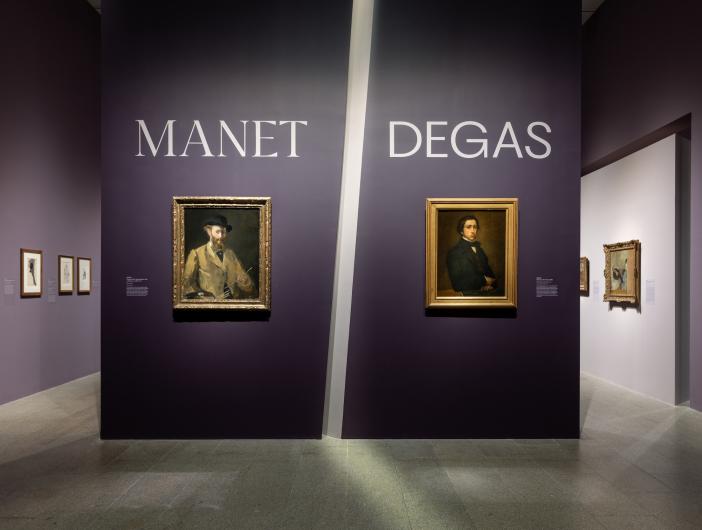
This year, The Metropolitan Museum of Art and the Musée d’Orsay jointly organized Manet / Degas, a compelling exhibition showcasing the significant works of Édouard Manet and Edgar Degas, exploring their relationships as friends, rivals, and antagonists. This impactful show delves into the intricate web of interactions between the two artists, examining their correspondences, connections with friends and family, and juxtaposes the similarities and differences in their artistic journeys and practices. It also boasts a major blockbuster artwork, Manet’s Olympia (1863), which with this show makes its U.S. debut. The work, hailed as a monument of modernism, contributes to the overarching goal of the show: to show that these artists defined modern painting in France.
Image: Entrance to the Manet / Degas exhibition at the Metropolitan Museum of Art
—Rebecca Schiffman
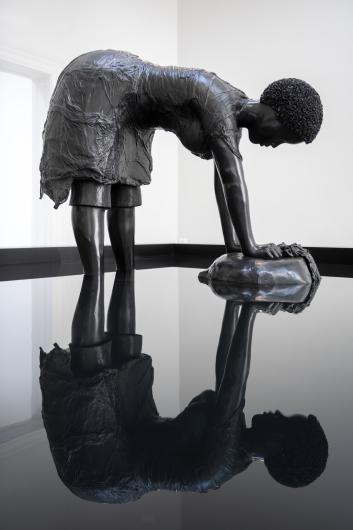
Simone Leigh’s (b.1967–) triumphant appearance representing the United States at the 59th Venice Biennale in 2022 brought her to the forefront of the international art world.
For most of us who were not able to travel to Venice, that work was reimagined in an exhibition at the Institute of Contemporary Art, Boston from April through September 4, 2023, providing a rare opportunity to experience this powerful presentation by a Black female artist at the height of her game. Broader in scope than the Biennale, the Boston show included works in ceramic, bronze, and video, spanning her career. It’s not too late if you missed it. Simone Leigh goes on tour in a joint presentation at the Los Angeles County Museum of Art (LACMA) and California African American Museum (CAAM) in Los Angeles (May 26, 2024–January 20, 2025). A major monograph accompanies the exhibition.
Image: Simone Leigh, Last Garment (2022). Installation view at “Simone Leigh,” the Institute of Contemporary Art/Boston, 2023.
—Cynthia Close
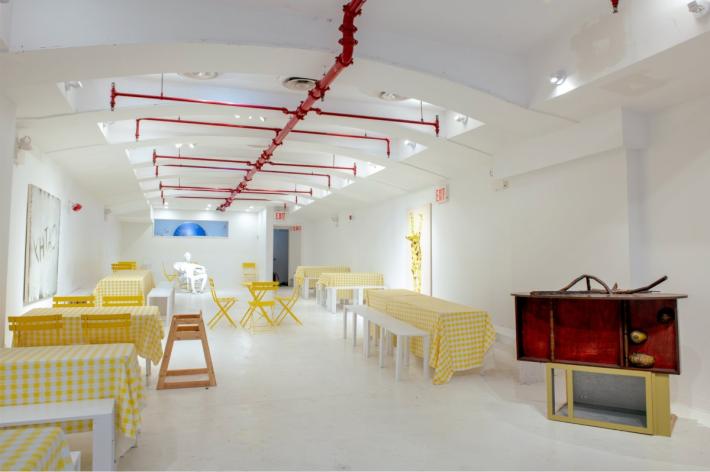
Founded by art star painter Jamian Juliano-Villani and Billy Grant, O’Flaherty’s is a non-traditional art venue that reminds me of the spaces happening in the mid-aughts (anyone else remember Deitch Project’s pop-up in Williamsburg, Brooklyn?). It’s the type of space where it seems as if anything goes, but in reality each exhibition is tightly curated. My first visit was for “The Cafe" (which ran from August to September 2023), and I happened upon it accidentally. But, upon entering, I found the show to be a fantastic conglomerate of established and lesser known artists. Works by George Segal stood alongside works by Josh Smith, Catherine Murphy, Merlin Carpenter, Sven Sachsalber, Cory Arcangel, and Brandon Ndife. I was only familiar with Segal, Smith, and Arcangel and delighted in the unconventional space and installation. While there was no sign of food being served, or having been served, upon my visit, I still decided to sit at a cafe table and proceeded to check my email.
Image: The main room at The Cafe at O'Flaherty's
—Katy Hamer
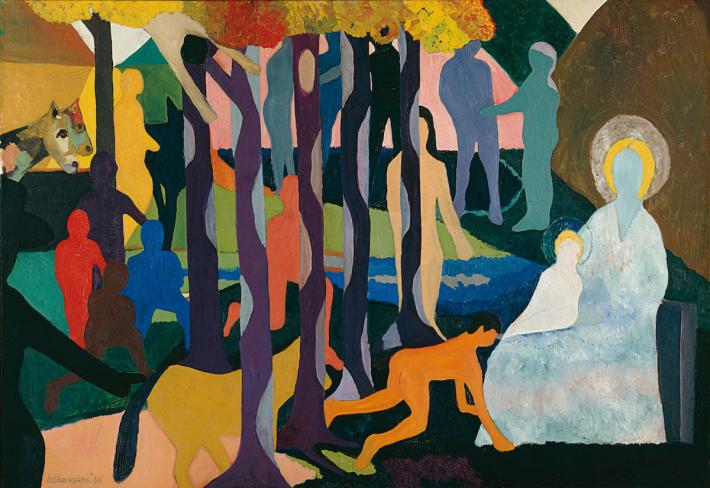
Stepping outside of what’s recognizable for 1960’s contemporaries, Bob Thompson’s bright canvases and homages to canonical paintings have been said to synthesize Renaissance masterpieces with the Abstract Expressionist movement, but travel far beyond. Bob Thompson: This House Is Mine, a nationally touring exhibition which ended at the Hammer Museum from October 2022 to January 2023, was the first museum show dedicated to the artist since his career retrospective at the Whitney Museum in 1998. Drawing inspiration from names such as Jacopo Tintoretto and Francisco de Goya, Thompson prompts the viewer to examine traditional forms from the perspective of an alternative lens, one that filters iconic mythologies through personal interpretation.
One example of this kind of transfiguration can be seen in the piece Blue Madonna, 1961. In the painting, a blonde-haired figure of the Virgin Mary can be seen to the far right with a child on her lap, as a man on all fours genuflects before her. Behind the man is the partial illustration of a horse, whose face is being bifurcated by a birch-like tree, along with the entire left side of the canvas. The line of purple-spotted foliage which divides the horse also separates the Madonna from multiple figures. The abstract mountain range as the backdrop highlights a pair which could be a reference to Adam and Eve, appearing at the top right of the canvas. Due to the colorful nature of the landscape's surroundings, a shadowy figure to the far left is almost overlooked. Wearing a top hat and pointing to either the horse or the religious figures, one is asked to question what true intention is hiding in the corner.
Image: Bob Thompson, Blue Madonna, 1961. Oil on canvas. 51 1/2 × 74 3/4 inches. The Detroit Institute of Arts. Gift of Edward Levine in memory of Bob Thompson.
—Carlota Gamboa
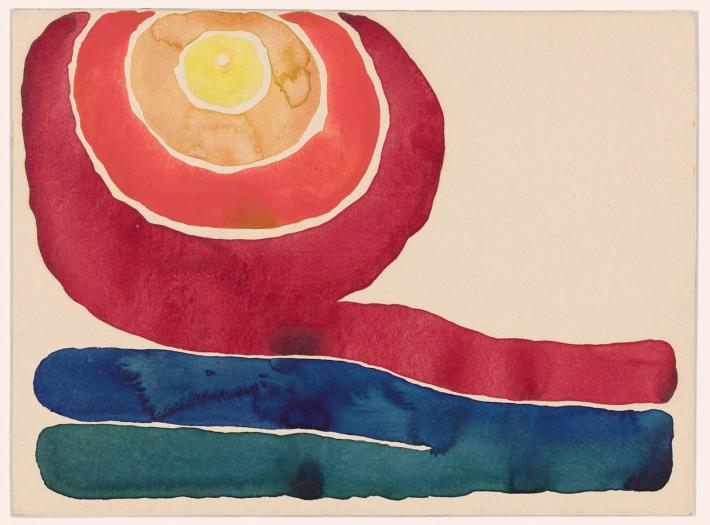
Georgia O’Keeffe: To See Takes Time at the Museum of Modern Art, exhibited a series of the artist’s works on paper–120 charcoal, watercolor, pastel, and graphite works created over four decades. Beginning with the early charcoal drawings that Stieglitz first exhibited at Gallery 291 in New York, O’Keeffe continually experimented with abstract forms, the figure and portrait, and the natural world. The MOMA show clearly exemplifies her greatness as a unique artist and innovator, far more than her ever-famous flower paintings ever could. The works here are spontaneous and filled with energetic confidence, as if they came from the subconscious speaking a universal language, and entirely beautiful.
Image: Georgia O’Keeffe. Evening Star No.III, 1917. Watercolor on paper mounted on board. 8 7/8 x 11 7/8″ (22.7 x 30.4 cm). The Museum of Modern Art, New York. Mr. and Mrs. Donald B. Straus Fund, 1958.
—Dian Parker
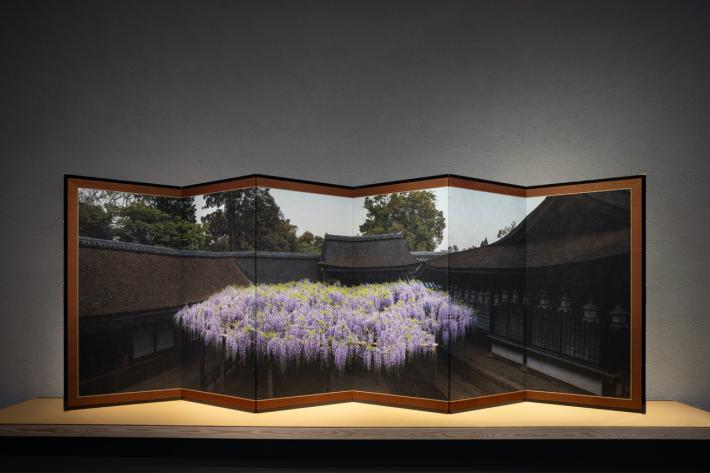
It’s been a seminal year for Hiroshi Sugimoto. Best known for his masterful photographs of artificial and natural realities, the artist and architect had a retrospective of his meditative photos at London’s prestigious Hayward Gallery; solo shows of new works at Gallery Koyanagi in Tokyo and San Francisco’s Fraenkel Gallery; a self-curated show of his work with historical artifacts at a celebrated Shinto shrine in Japan; and this engaging exhibition of works by the revered artist created in dialogue with the past.
At the core of the Shoto show were several traditional screens and scrolls displaying the artist’s earlier and recent photographs. Exploring the 12th-century Japanese concept of honkadori—an allusion within a poem to an older poem that its potential readers would readily recognize—Sugimoto brings honkadori’s history and techniques to fruition in his visual works. Referencing historical paintings, he used photography to turn them into contemporary works like Wisteria of Kasuga Grand Shrine (2022), which captures the flowering 1000-year-old plants from the angle of the gods gazing upon the temple on a classic screen. Sugimoto paired his screens and scrolls with poetic displays of ancient objects and his new series of Brush Impression pictures, which offer chemically stroked calligraphy as expressive photograms.
Image: Hiroshi Sugimoto, Wisteria of Kasuga Grand Shrine, 2022. Pigment print on Japanese rice paper, mounted to a folding screen. Edition of 3 + 1 AP. 71-1/4 x 216 inches (overall) [181 x 548.6 cm]
—Paul Laster
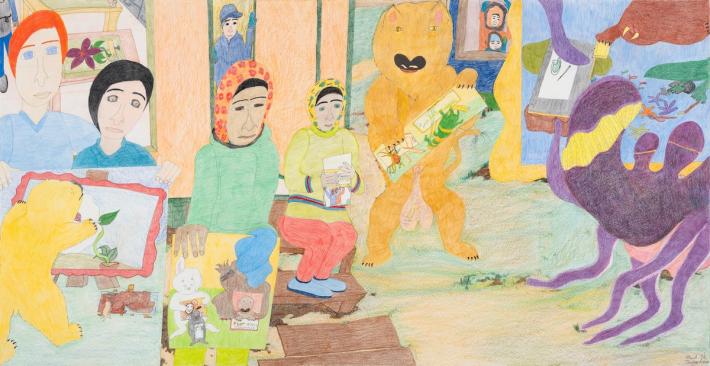
We had not thought much or learned about Arctic artists until we visited Fort Gansevoort's Shuvinai Ashoona exhibition this fall. Ashoona's massive works, some over eight feet long, vividly depict monochromatic landscapes and lively scenes of contemporary Inuit life. Based in Kinngait, an Inuit hamlet on Baffin Island, Ashoona is part of the West Baffin Cooperative, where over 10 percent of the 2,000-person community are artists, according to First Nations curator Candice Hopkins. The exhibition not only showcases visually striking pieces but also narrates universal stories of community, identity, intergenerational trauma, and climate change—themes resonating in contexts beyond the Arctic.
Image: Shuvinai Ashoona, Polar bear sketching people, 2023. Colored pencil and ink on paper. 50.25×97.25 inches.
—Rebecca Schiffman
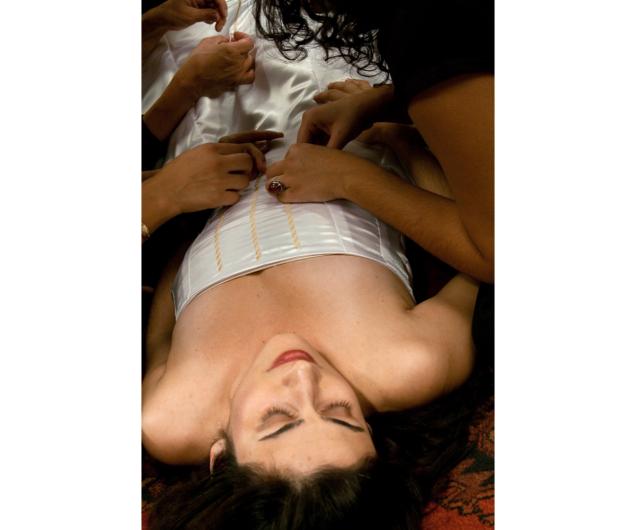
Women Defining Women, at LACMA in April of 2023, featured 75 works by artists from Islamic backgrounds, invested in breaking the conceptions of silence or submission placed on women from these regions.
Curated by Linda Komaroff, Sarah Mostafa Ahmed and Stephanie Rouinfar, the social and political commentary of the selected works focused on the feminine experience from Africa to Western and Central Asia, as well as outside diasporic communities.
One standout work had to be the moving six-minute thirty-second video by Gazelle Samizay entitled Upon My Daughter (2010). Experienced like a body-horror short, the viewer sees a young woman in a bridal gown surrounded by older women who seem to be preparing her. The delicate shots of the girl in the dress are paired with zoomed in images of the group hemming and detailing the fabric.
The video moves from slow and aesthetic shots of the women to choppy edits of stitches becomeing cumbersome and ultimately entangling the inccreasingly fraught bride. What was once a maternal scene becomes claustrophobic and suffocating. The work conveys Samizay’s experience as an Afghan woman, while touching on the pressures and societal constraints faced by women around the world.
Image: Gazelle Samizay, Upon My Daughter, 2010. Single-channel video. Duration: 6 minutes, 27 seconds. Los Angeles County Museum of Art, Purchased with funds provided by JoAnn Busuttil.
—Carlota Gamboa
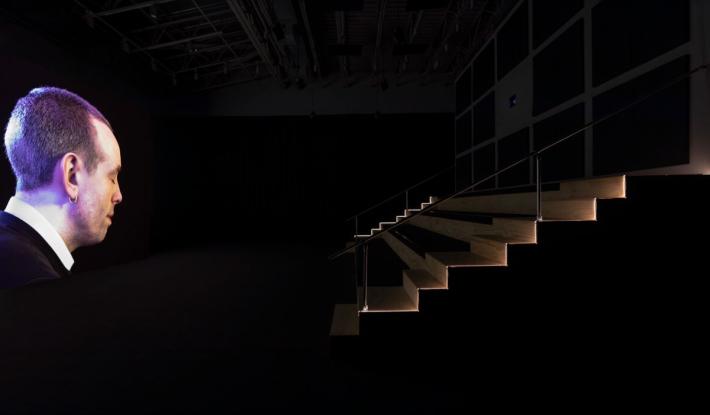
Ed Atkins is an artist who for years has manifested his own likeness in digital rendering, accompanied by subjugated text, that is derived from various sources. No matter how disjointed the work may seem at first, he always manages to communicate within a stark, contemporary, conceptual and theoretical discourse about our time. This is also the case with two new short films at Gladstone Gallery. The first, Sorcerer is a collaboration with Steven Zultansky and finds 3 characters waxing poetic about themes that range from the horrific (scooping one’s eyes out) to the banal. It takes place on a stage setting and while audibly charged, nothing is graphic beyond the imagination of the viewer. The second film, Pianowork 2 finds an avatar of Atkins sitting at a 3D-rendered piano, painstakingly playing Jürg Frey’s, Klavierstuck 2, a slow composition that ends with the avatar of Atkins crying digital tears. In both works, Atkins tests the boundaries of filmmaking, theater, and sculpture, harkening back to ancient emotions, withdrawn in a very
contemporary way.
Image: Installation view of Ed Atkins iwth Steven Zultanski
—Katy Hamer
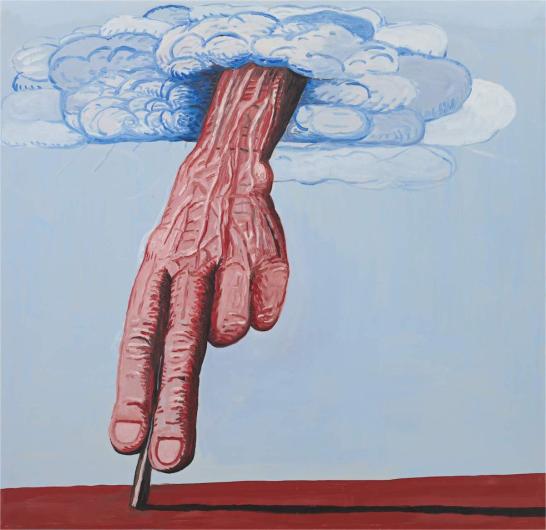
Contemporary artist Philip Guston (1913-1980) was a fearless experimenter throughout his career. His personal life was marked by tragedy and his paintings were both adored and maligned in his own time. Schooled in the Renaissance tradition, he rode a wave of popularity with his sumptuous abstractions in the 1950s-1960s, only to return to powerful and controversial cartoon-like imagery in the 1970s reflecting his concern with racism and his own mortality. The greatly anticipated show, Philip Guston Now, was long delayed due to COVID closures. It opened to great fanfare at MFA, Boston on May 1, 2022 but the trigger warnings that accompanied the installation were problematic for most critics. After traveling to The National Gallery of Art in Washington DC, and the Museum of Fine Arts, Houston, the show can now be seen at Tate Modern through February 2024.
Image: Philip Guston, The Line, 1978.
—Cynthia Close
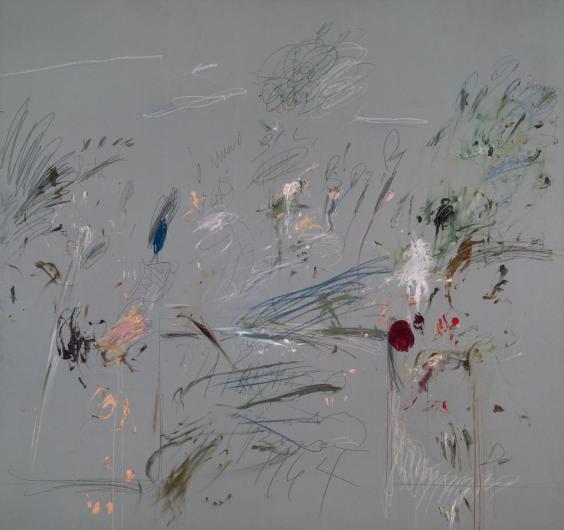
Making Past Present: Cy Twombly at the Museum of Fine Arts, Boston was a knockout. 60 paintings, sculptures, drawings, photographs, and prints were exhibited, interspersed with his personal collection of antiquities, as well as 30 ancient artworks from the MFA’s collection. The result was a powerful, diaristic exhibition of Twombly’s lifelong passion for Ancient Greek, Roman, and Egyptian myth and poetry. The multilayered palimpsest paintings, sculptures of found objects slathered with plaster of Paris and white paint, the delightful mixed-media drawings with fervid color—everything resounded with Twombly’s exuberant, joyful approach to art-making. This remarkable exhibition brought the long distant past forward in new and thrilling ways, showing Cy Twombly’s explosive imagination and life force.
Image: Cy Twombly, Il Parnasso, Oil, wax crayon, graphite, and colored pencil on canvas, 1964. Photograph by Greg Heins. Promised gift of Ann and Graham Gund in honor of the 150th anniversary of the Museum of Fine Arts, Boston. © Cy Twombly Foundation.
—Dian Parker























